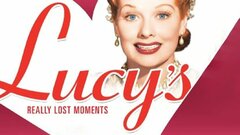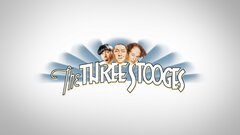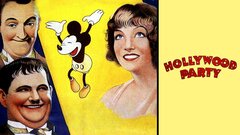The middleman for the comedy trio known as The Three Stooges, Larry Fine endured endless slaps, pokes in the eye and mallets to the head, all for the sake of laughter. Alongside brothers Moe and Shemp Howard, Larry first found fame as a member of the vaudeville musical-comedy act, Ted Healy and his Stooges. But it was only after the Howard's younger brother, Jerome - renamed "Curly" - replaced Shemp and the trio became a solo act officially known as the Three Stooges, that they achieved massive success on a national level.
For Columbia Pictures, the Three Stooges would star in nearly 200 short films over a remarkable 24 year period. Both revered and reviled for their gleefully violent slapstick, Larry, Moe and Curly became an indelible part of American pop culture. Over the course of a nearly 40 year career, there were several changes in the line-up - Curly's health problems brought back Shemp, who in turn was replaced by comedian Joe Besser, who eventually gave way to "Curly Joe" DeRita. Throughout it all, however, Larry remained a constant presence alongside Moe, lending an understated sense of calm to the chaotic proceedings.
Often underappreciated as a comedic actor, Fine was later praised by lifelong Stooge fanatic and filmmaker Peter Farrelly, who said that while children were drawn to Curly and teens tended to appreciate Moe, "Anyone out of college, if you're not looking at Larry, you don't have a good brain."
Born Louis Feinberg on Oct. 5, 1902 in Philadelphia, PA, he was the oldest of four children born to Fanny and Joseph Feinberg, who owned a watch repair and jewelry business. Precocious and playful from a young age, Larry, as he later became known, suffered a horrifying accident as a toddler when he picked up a bottle of acid his father used for testing the authenticity of gold and, thinking it was water, attempted to drink it. Reacting instinctively, Joseph slapped the bottle out of his son's hand at the last minute, spilling the corrosive substance on Larry's forearm. Badly burned, the youngster underwent immediate skin grafts and at his doctor's suggestion, later studied the violin as a means of strengthening his damaged arm. Larry soon became so proficient with the instrument that he was soon entertaining family and friends and later soloing in concerts put on at his school. Larry also exhibited a knack for comedy which, when combined with his talent as a musician, made him a perfect fit for work on the vaudeville circuit.
Having also briefly entertained a career as an amateur boxer until his father made him quit, Larry was performing regularly as a violinist accompanying movie slideshows for two dollars a show while still in high school. In 1921, going under the surname of Fine, he joined the Gus Edwards Newsboy Sextette as a musician, dancer and comedian. It was during this time that he met fellow performer Mabel Haney, whom he would later marry. Along with Mabel and her sister Loretta, Larry formed the trio of The Haney Sisters and Fine in 1922. During a 1925 performance in Chicago, Fine was noticed by noted vaudevillian Ted Healy, along with Moe and Shemp Howard, who were then known collectively as Ted Healy and his Racketeers. Acting as Healy's comedic foils, the Howard brothers filled the role of the so-called "Stooges" in the act. Although their act was enjoying substantial success, Shemp was by then looking to branch out as a solo artist.
After Moe suggested that Fine might make a good replacement for his brother, Healy offered the red-headed performer $90 a week to become a Stooge, with an additional $10 if he would ditch the violin. Larry quickly accepted the offer and when Shemp returned to the group after his short-lived solo effort, they began calling the act Ted Healy and his Stooges. Not long after making their Broadway debut in the popular musical revue, "A Night in Venice" in 1929, Healy and his boys appeared on the silver screen for the first time as a team in the Rube Goldberg comedy, "Soup to Nuts" (1930). Interestingly, at this early stage, it was the elder Shemp who was clearly the Stooge in charge, as Moe had yet to assume his role of authority. Larry, however, was and would ever remain the constant of the trio, reacting naturally to the over-the-top performances of the Howard brothers and attempting to be the voice of reason, however ineffectively.
The group soon returned to Broadway, but by 1932 both Healy's desire to pursue more work in film and Shemp's continued dissatisfaction with playing a Stooge - exacerbated by Healy's abusive, alcoholic tendencies - resulted in Shemp departing once again. In need of a third Stooge, Moe immediately suggested his younger brother, Jerome, who promptly shaved his head and took on the ironic name of "Curly" in order to seal the deal.
A contract with MGM followed, with Larry, Moe and Curly livening up the proceedings in several films opposite Healy and such MGM stars as Clark Gable and Joan Crawford. Eventually Healy also ventured on, leaving Larry and his cohorts free to sign up with Columbia Pictures, where the trio would make no fewer than 190 two-reel shorts between 1934 and 1958 as the Three Stooges. The first of the official Stooge films was the musical novelty short, "Women Haters" (1934), in which the boys - as characters NOT called Larry, Moe and Curly for the only time - hilariously tried to resist the charms of the fairer sex. Though still in an early form, all the iconic Stooge comedy bits were present in "Women Haters" - the eye pokes, exaggerated sound effects, even Curly's signature laugh of, "Nyuck, nyuck, nyuck." And all the while, Larry provided a perfect middle ground between Moe's aggressive bossiness and Curly's manic man-child shenanigans.
That same breakout year marked several other "first and only" milestones for Larry and his comic coconspirators. "Punch Drunks" (1934) - in which Curly is exploited in the boxing ring after Moe discovers that he flies into an uncontrollable rage whenever he hears "Pop Goes the Weasel" - was the only effort crediting all three Stooges as writers. The first romp to feature the catchphrase, "Calling Dr. Howard, Dr. Fine, Dr. Howard," the short, "Men in Black" (1934) was also the only Stooge film to be nominated for an Academy Award for Best Short Subject. Often overshadowed by his showier counterparts, Larry was an essential ingredient in the success the Three Stooges enjoyed during those halcyon years with Columbia. And while youngsters were reduced to giggling hysterics by their violent physical comedy, parents were notoriously wary of the material, fearing their impressionable children might imitate the trademark eye gouges, or pinch a sibling's nose with a pair of pliers. Truth, be told, the onscreen rough-housing occasionally did result in a cracked rib or skull for the committed comedians.
The 1940s and America's entry into World War II quickly provided the Three Stooges with one of their easiest targets ever: Adolph Hitler. Moe caricatured the Nazi dictator for the first time as the puppet leader of the country "Moronica" in the side-splitting satire, "You Nazty Spy!" (1940), which was a particular favorite of Larry's. In contrast to the never-ending hardships the trio comically faced on screen, real-life tragedy struck when immediately after filming "Half-Wits Holiday" (1947), Curly suffered a debilitating stroke that forced him to retire from show business. Optimistic as they were, Larry and Moe hoped that Curly's withdrawal would be a temporary one and convinced a reluctant Shemp to rejoin the group until such time as the younger Howard felt well enough to return. Unfortunately, the recuperation never came. Other than a brief cameo in "Hold That Lion" (1947) - featuring the only scene in which Larry, Moe, Shemp and Curly all appeared onscreen together - Curly never performed again. After a series of strokes that left him increasingly infirmed, the youngest Stooge died in a nursing facility in 1952 at the all-too-young age of 48.
Less focused on work than Moe and far less self-destructive than Curly, Larry nonetheless had his fair share of flaws and foibles. Chronically late for engagements, Moe and Curly (and later, Shemp) were frequently forced to stall interviewers, camera crews and audiences as they waited for their tardy partner to arrive. This lackadaisical attitude to work crossed over to matters of finance as well. For Larry, money was meant to spend, not save, and he did so freely, often gambling away his salary or loaning out large sums of money to any friend pitching an investment scheme. Nomadic by nature, Larry and Mabel preferred hotel living, moving the family from the President Hotel in Atlantic City to Hollywood's famed Knickerbocker Hotel for a number of years before finally purchasing a home of their own in the Los Feliz area in the late-1940s.
By 1948 it was clear that Curly's temporary retirement would be permanent, prompting Larry and Moe to convince Shemp to remain with the Stooges, despite the latter's desire to maintain a solo career. Although Curly would forever remain a favorite with fans, the group continued to enjoy substantial popularity throughout the remainder of the 1940s and well into the next decade, with memorable shorts like "I'm a Monkey's Uncle" (1948) and "Corny Casanovas" (1952). Then, in a one-two punch of tragedy, a mere three years after Curly's passing, Shemp died from a heart attack in 1955 after appearing in more than 70 shorts with Larry and Moe. The heartbreak of losing his two brothers proved almost too much for Moe, who seriously considered ending the act permanently. While Moe contemplated what to do next, the final few films scheduled with Shemp were cobbled together using existing footage of the older Stooge and stand-in Joe Palma - referred to as "Fake Shemp" in Stooges lore - for efforts like "Rumpus in the Harem" (1956) and "Commotion on the Ocean" (1956).
With a few more years left on their contract with Columbia, Larry and Moe ultimately decided to recruit portly comedian Joe Besser to come aboard as the third Stooge. For most fans, this period of the classic Three Stooges was by far the worst. Besser, a talented comedian in his own right, had a whining delivery that did not sit well with established rough-house repartee of the previous era. Additionally, the short-subject department was being downsized at Columbia, resulting in increasingly rushed production schedules and more dependence on recycling footage and storylines from earlier films. Besser contributed to 16 shorts alongside Larry and Moe, until Columbia chose not to renew their contract in late-1957, unceremoniously ending a 24-year relationship - the longest of any comedy group in movie history. Though Moe was the de facto business manager for the Stooges, and managed his own money wisely, he unfortunately failed to parlay the group's popularity into higher paychecks. Paid a substantial $20,000 per month when they began their stay at Columbia, they were making the exact same salary a quarter of a decade later. For his part, Larry had managed his own finances so poorly over the years that he suddenly found himself on the verge of bankruptcy.
With no contract in hand and Besser leaving the group soon after their firing by Columbia, Moe was at last ready to concede to retirement, much to the dismay of a financially strapped Larry. Television, however, had by this point become a ubiquitous presence in the American household, and after Columbia began releasing the Stooges vast catalogue of short films in syndication, Larry and Moe were shocked to see a sudden resurgence of interest in their old comedy team. Intending to give audiences one last peek at the Stooges, Moe recruited comedian Joe DeRita to join him and Larry for a live, one-night farewell performance. When the show sold out, they quickly signed DeRita - dubbed "Curly Joe" - full-time and went back to the studio. This latest roster of Stooges went on to star in six full-length features, beginning with the space romp, "Have Rocket - Will Travel" (1959) and ending with "The Outlaws is Coming!" (1965). As popular as ever - admittedly now more as kitsch than contemporary comedy - the Three Stooges could be seen in cameo appearances in major films and television specials. Their goofy visages even adorned lunch boxes and comic books. Moe and the boys recorded dozens of live-action skits that bookended the regular segments of their own cartoon series, "The New 3 Stooges" (syndicated, 1965-66). But as fond as America still was of their beloved Stooges, it became increasingly clear that age was catching up with Larry and Moe, as their pacing slowed down and the physical comedy, once so kinetic and brutal, had been reduced to little more than a playful tussle amongst old men.
Performing up to their usual standards was becoming particularly difficult for Larry, who was beginning to have trouble saying his lines - a sign of the strokes that would increasingly plague him in the years to come. Larry, Moe and Curly Joe made one last memorable appearance as the "Three Men in a Tub" in an episode of the primetime children's fantasy show "Off To See the Wizard" (ABC, 1967-68). Despite their advanced ages, they continued to develop more Three Stooges ventures, leading them to once again attempt to get a weekly television series off the ground. Although earlier small-screen efforts - "Jerks of All Trades" (1949) and "The Three Stooges Scrapbook" (1960) - had failed to bear fruit, the trio went to bat again with "Kook's Tour" (1970), a pilot for an intended series that would feature the "retired" Stooges gallivanting around the globe and causing chaos. Plans were scrapped, however, after Larry suffered a debilitating stroke that paralyzed the entire left side of his body shortly after filming the unaired program. Following another series of strokes, Larry Fine died at the age of 72 in January 1975. More than 40 years after "Kook's Tour," The Three Stooges remained a constant presence on television and at fan conventions held nationwide. A cinematic love letter was later delivered by Stooge devotees, comedy filmmakers Bobby and Peter Farrelly who co-wrote and directed the hilarious homage, "The Three Stooges" (2012), with actor Sean Hayes in the role of Fine.
By Bryce Coleman
































































![CAPTAIN HATES THE SEA, THE, Moe Howard, Larry Fine, Curly Howard [The Three Stooges], 1934](https://media.baselineresearch.com/images/422118/422118_small.jpg)
![FOUR FOR TEXAS, Larry Fine, Moe Howard, Joe De Rita [The Three Stooges], 1964](https://media.baselineresearch.com/images/415525/415525_small.jpg)



![GOLD RAIDERS, THE, Moe Howard, Shemp Howard, Larry Fine [The Three Stooges], 1950](https://media.baselineresearch.com/images/413834/413834_small.jpg)
![IT'S A MAD MAD MAD MAD WORLD, Joe De Rida, Moe Howard, Larry Fine [The Three Stooges], 1963](https://media.baselineresearch.com/images/409856/409856_small.jpg)







![HAVE ROCKET WILL TRAVEL, from left: Larry Fine, Moe Howard, Joe DeRita [The Three Stooges], 1959](https://media.baselineresearch.com/images/374476/374476_small.jpg)





















![HAVE ROCKET, WILL TRAVEL, Larry Fine, Moe Howard, Joe De Rita [The Three Stooges], 1959](https://media.baselineresearch.com/images/126012/126012_small.jpg)
![HAVE ROCKET, WILL TRAVEL, Curly Joe De Rita, Larry Fine, Moe Howard [Three Stooges], 1959](https://media.baselineresearch.com/images/126011/126011_small.jpg)


























